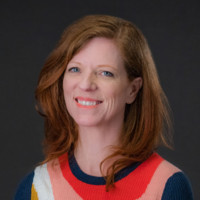
Bridget O'Rourke
- Courses4
- Reviews27
- School: Elmhurst College
- Campus:
- Department: English
- Email address: Join to see
- Phone: Join to see
-
Location:
190 S Prospect Ave
Elmhurst, IL - 60126 - Dates at Elmhurst College: November 2007 - December 2018
- Office Hours: Join to see
Biography
Elmhurst College - English
Resume
1998
Teaching
Research
Higher Education
Program Development
Grant Writing
“‘To Learn from Life Itself’: Experience and Education at Hull-House.”
My contribution to the edited collection Jane Addams in the Classroom illuminates Jane Addams' influence on the living tradition of American education. John Dewey's contribution to progressive education has long been recognized; however
few are aware that Addams' model of experiential education (enacted at Hull-House) served as the model for Dewey's experimental Lab School. Addams has been viewed as primarily a social worker
even though she claimed education as the settlement's primary calling. My essay reclaims Addams’ feminist model of experiential education and the corresponding mutual engagement of students and teachers in a reciprocal process of “learning from life itself.” I hope contemporary readers will find this model relevant and useful as a basis for transforming conflicts and mistakes of the past into meaningful collective action.
“‘To Learn from Life Itself’: Experience and Education at Hull-House.”
This remake of John Cage's audio composition \"Roaratorio\" was originally motivated by my desire to explore the dementia experienced by my father
Timothy O'Rourke
who had entered the late stages of Alzheimer’s disease. Reading James Joyce's experimental novel _Finnegans Wake_ provided a bridge to the realm of sound and language that lies beyond the cognitive domain.\n\nThe recording features a reading by Elmhurst College alum Lee Borocz-Johnson of John Cage's composition “Writing Through Finnegans Wake for the Fourth Time
” accompanied by original music and found sounds recorded and remixed by EC alum and recording artist Elvis Andruzkiewicz.
“RoaraTORio: A Senescent Circus on Finnegans Wake”
The Federal Writers' Project of the Works Progress Administration (WPA) collected songs
tall tales
urban myths and legends
and other genres of urban industrial folklore during the late 1930s. This article focuses on the WPA life histories produced by the Chicago Industrial Lore unit of the Illinois Writers' Project
many examples of which are accessible to scholars through the Library of Congress' American Memory web site. \n\nBenjamin Botkin
the director of the WPA's folklore division
influenced the scope
methods and aims of the industrial folklore collection. Botkin theorized the “creative reciprocity” between the folk and the individual
by which the individual writer constitutes and is constituted by folk culture. Botkin's leadership of the folklore division gave him an opportunity to apply theories of socioeconomic integration and creative reciprocity of the folk and the individual on a broad scale as he led a national workforce of unemployed workers with close ties to the diverse cultures of local immigrant and minority communities they investigated.
“Highpockets and Bottom Dogs: The Industrial Folklore of the Federal Writers' Project.”
“Hilda Satt Polacheck and the Urban Folklore of Chicago’s Hull-House Neighborhood.”
Review of _Composition & Copyright: Perspectives on Teaching
Text-Making and Fair Use. _
\"O’Rourke and Shaw start with the recitation of Sandhyas! Sandhyas! Sandhyas! (593.1)” at the opening of book 4 of the Wake and delve into the direct and oblique meanings of Joyce’s use
and apparent use
of Sanskrit
Tantric and Hindu references throughout. The authors utilize especially the texts with which Joyce acquainted himself with Eastern thought
namely those from Heinrich Zimmer and H.P [Madame] Blavatsky. \n\n\"Many references tie directly to various gods and teachings in Hindu/Vedic mythology
and O’Rourke and Shaw not only explicate the mentions of such figures as Shiva
Shakti and Lakshmi as they relate to the teachings of the Hindu self and certain Buddhist tenets
but also how they overlap with other faith figures
such as St. Kevin. One particularly interesting element is Joyce’s use of “tat tvam asi
something which provides
along with several other phrases
an uncanny overlap between Freud
Kant and characteristics of Vedic mythology.\" (from the introduction by editor Zach Mullen).
“The Yoga of Finnegans Wake.”
Joyce Without Borders 2019 North American James Joyce Symposium in Mexico City: Can the Sepoy Speak? The 'Hindoo Seeboy' as Anti-Colonial Indic/Irish Insurgent in Finnegans Wake (June 13
2019)
Bridget
O'Rourke
Elmhurst College
Elmhurst
Illinois
Professor and Writing Program Director
Department of English
Elmhurst College
M.A
ENGLISH
English
B.A
PH.D
Composition III: Classical Rhetoric and Contemporary Discourse
Composition II
Composition IV: Composition Theory and Research



